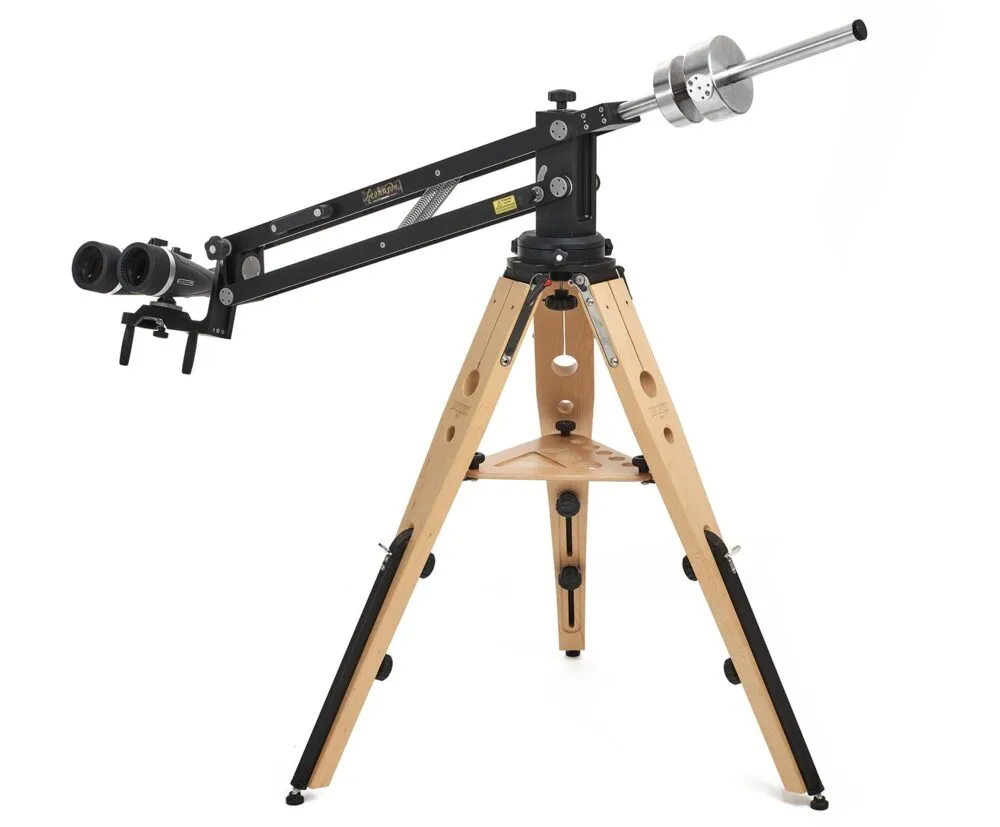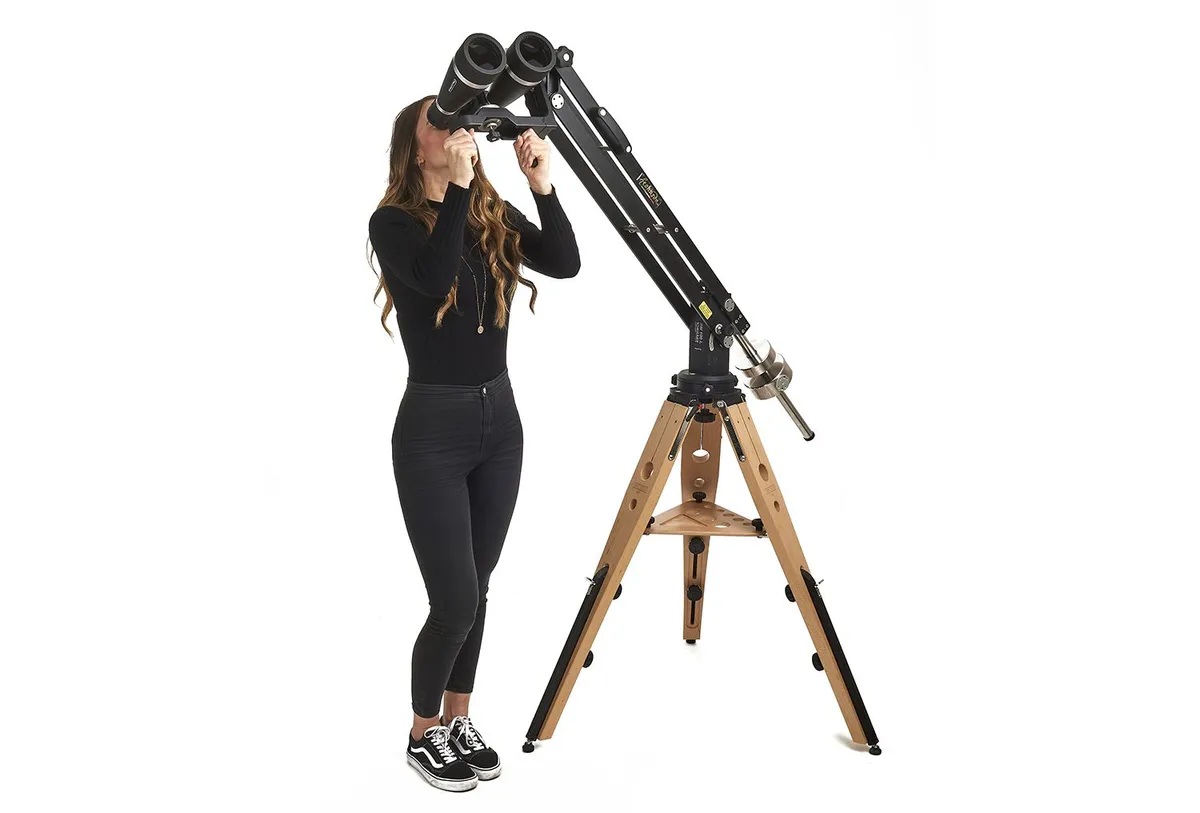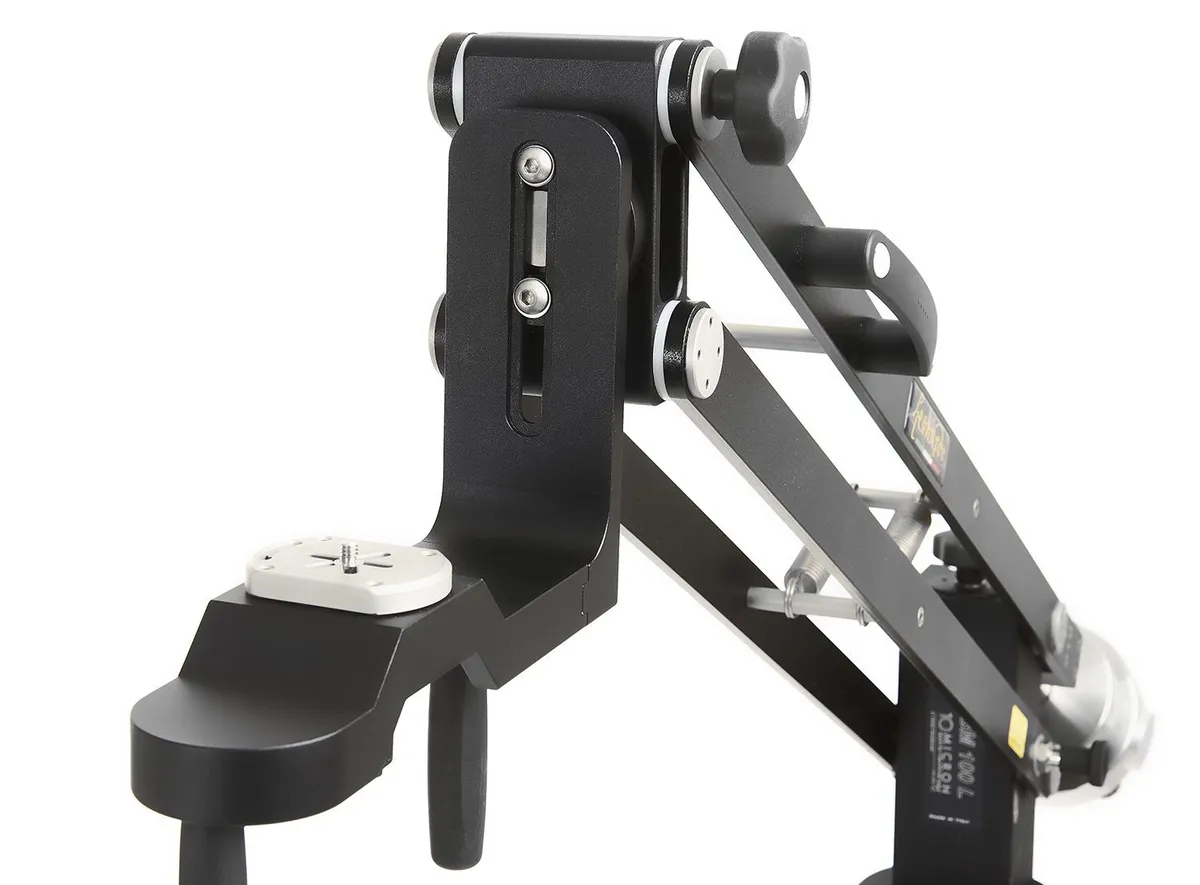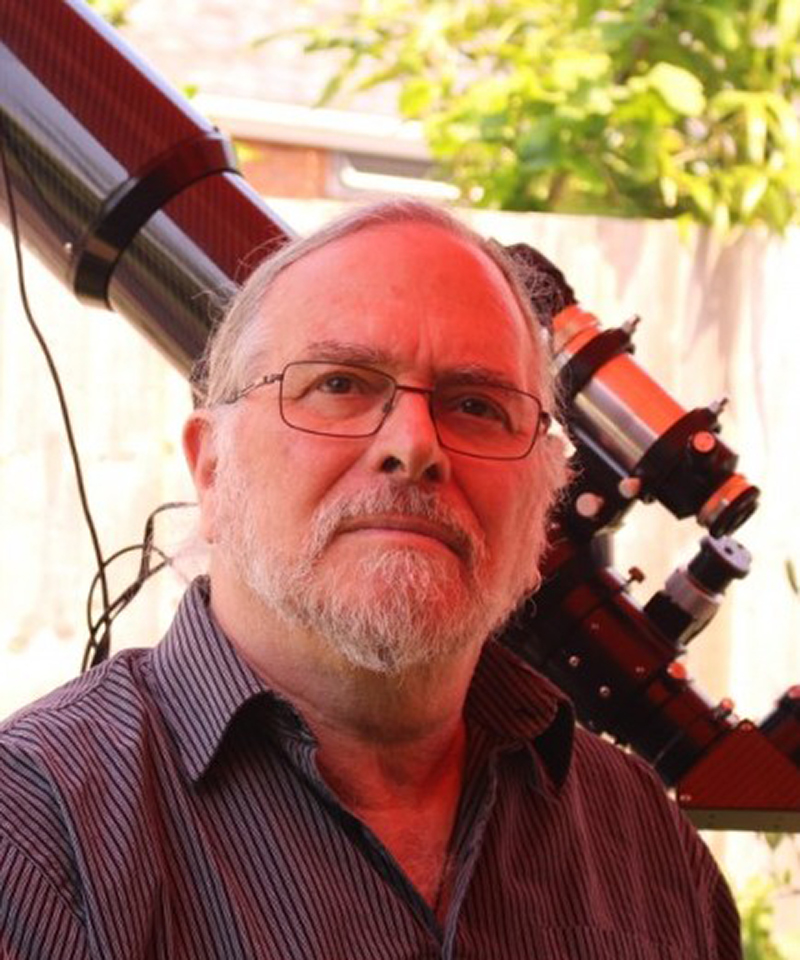Celestron’s new SkyMaster Pro range of binoculars has an attractive array of specifications, and 10Micron has a reputation for well-implemented mounts. So, how do they pair up?
The SkyMaster Pro 20x80 binoculars have a Porro-prism centre-focus design, with the satisfyingly sturdy feel of substantial textured rubber armour covering the aluminium and polycarbonate body.
The hinge, focus and right eyepiece adjustment all operate smoothly, with an appropriate amount of resistance so that they do not become unintentionally adjusted.
As the objective caps are tethered securely they won’t get lost, and they are immediately available to delay dewing should you take a break in observing.
A unique feature is the interchangeable eye cups: you can choose normal or winged. The winged eye cups effectively shield your eyes from stray light, but they have to be folded down to get the rainguard-type lens caps on.
Unfortunately, they have an annoying tendency to come off when you fold them back up again. In the body of the binoculars, the prisms are secured in a proper cage, not merely clipped to the housing.
Further testing confirmed that the binoculars are not internally stopped down and they pass light from the full 80mm aperture to the eyepiece.
When you remove the Leonardo parallelogram mount from its box, the rigidity of construction and fine quality of finish immediately become apparent.
We were delighted that a locking pin ensures there is none of the notorious finger-trapping parallelogram movement as you take it out. This locking mechanism is also useful when you are attaching the binoculars and counterweights.
You first need to assemble the instrument platform, which attaches to a dovetail on the parallelogram.
The short 30mm diameter counterweight bar screws into the tripod end of the parallelogram, its weight, augmented by double counter-balance springs in the parallelogram structure, helps to balance the load.
You will need a substantial tripod or pier, and the package includes a very versatile base-adaptor plate. It is specifically designed for the 10Micron/Geoptik range of tripods (the supplier kindly loaned us a Geoptik Hercules 95) but the pre-drilled holes permit it to be used with other heavy-duty options, so we also tried it on an iOptron Tri-Pier. Both were rock steady.
These binoculars appear on our list of the best binoculars for astronomy and stargazing

In the balance
You can lock the parallelogram horizontally when you fit the binoculars and counterweights, and also gradually slacken the friction to achieve perfect balance as you adjust the counterweights.
We found it easier to attach the binoculars with them pointing vertically, because the mounting screw (option of 1/4-inch or 3/8-inch) locking system on the mounting plate is activated by gravity.We needed to use both the 6kg and 3kg weights to balance the binoculars.
Once it is set up, it’s a joy to use, and the exquisite engineering design of the mount becomes apparent. Everything operates smoothly and there are ‘warm-touch’ handles and knobs where you would want them.
The binoculars gave a bright, contrasty image, that was crisp over the central half of the field of view and – other than obtrusive off-axis chromatic aberration on bright objects – was acceptable outside this except at the edge.
The proximity of a first quarter Moon did not result in ghost images or spurious reflections.
The mount is specified for loads up to 13kg, so we also tried the heaviest binoculars we had available – 37x100s, weighing 6.5kg – which we augmented with a 4kg weight.The Leonardo handled this weightier model with ease.
The SkyMaster Pro binoculars will suit someone who has exhausted the possibilities of an entry-level model and who wants a decent quality, large aperture instrument with the convenience of centre-focus.
The Leonardo mount will suit this purpose and will be a future-proof option for anyone who may later upgrade to bigger binoculars who wants a substantial parallelogram that will last a lifetime.

Crystal clear views
To get the clearest visual images from binoculars, you need good optics that are held rock steady.The SkyMaster Pro binoculars meet part of this requirement.
The contrast between the background sky on one hand, and the light from stars, planets and deep-sky objects on the other, is apparent all over the field, and especially so in the middle.
The anti-reflective coatings and well-designed light baffles play their part very well. Of course, this would be wasted if the image was dancing over the sky, and here the mount has to earn its keep.
With the BM100 Leonardo, you don’t need to worry about ‘the wobbles’. It has exceptional torsional rigidity and the relatively short counterweight bar all but eliminates the longitudinal oscillation that can sometimes plague long-arm parallelograms.
After acquiring your target object, you have little more than a second before the visual image is perfectly still, and the result is that you can push the binoculars to the best of their ability.

Waterproof and nitrogen-filled
Dew is the bane of every binocular observer, but not only does it spoil your view of the heavens, it also potentially ruins your binoculars if it gets inside. Waterproofing is therefore a ‘must-have’ option for an astronomical binocular, and the addition of dry nitrogen filling will inhibit corrosion by oxidation.
Adjustable instrument platform
Binocular mounts work best when the altitude fulcrum is aligned with the centre of mass of the binoculars. If it’s not, they will become unbalanced as the target elevation changes. The slotted mounting holes on the instrument platform dovetail plate enable this adjustment to be made.
Adjustable height and azimuth friction
Low friction motions on a parallelogram mount give a sensation that the binoculars are floating in space, but this becomes inconvenient if you are using it in windy conditions or situations where the binoculars can easily be nudged. Your ability to increase the friction minimises the effect of these adversities.
Finder rail
Mounted binoculars can be more difficult to aim than hand-held ones, especially when they have high magnification and, therefore, small fields of view. These binoculars are provided with a detachable rail on which you can mount a red dot finder (not included), making target acquisition a cinch.
Good stray light control
Celestron controls the scourge of stray light in two ways: the XLT multi-coatings increase light throughput and reduce the likelihood of internal reflections forming ghost images. The objective tubes also incorporate two light baffles, which effectively eliminate reflections off the tube interiors. The consequence is excellent image contrast.
Vital stats
- Price £230 binoculars; £1,995 mount (tripod not included)
- Optics fully multi-coated
- Aperture and magnification 80mm, 20x
- Prisms BaK-4
- Angular field of view 3.2°
- Focusing centre focus
- Height range of mount 150cm
- Mount load capacity 13kg
- Weight 2.4kg binoculars; 13kg mount
- Supplier David Hinds Ltd
- Tel +44 (0)1525 852696
- www.dhinds.co.uk
This review originally appeared in the January 2020 issue of BBC Sky at Night Magazine.
